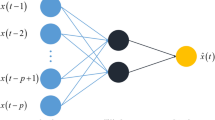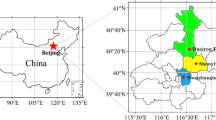Abstract
In view of the serious harm to human health caused by atmospheric fine particulate matter (PM2.5), accurate prediction of high concentrations of PM2.5 can help to provide timely warnings. On the other hand, due to the complexity of the formation and transmission process, it is difficult to accurately predict PM2.5. The aim of this paper is to develop a hybrid interval-valued time series prediction model, namely, BEMDCR-SE-PSO-SVM, by considering daily changes in pollutant concentrations and thereby realize interval-valued PM2.5 concentration prediction with high accuracy. The theoretical contributions in this paper include (1) the problem of edge effects corresponding to BEMD associated with interval-valued time-series is addressed by using the mirror extension method, and (2) the transformation between interval-valued time series and complex-valued signals is renewed from the perspective of centre/radius so that lower data fluctuations can be obtained. Technologically, sample entropy is introduced to provide an objective way to integrate decomposed similar IMFs so that subsequent prediction processes can be simplified. Finally, a numerical example is shown to illustrate the feasibility and validity of the developed hybrid interval-valued time series prediction model.








Similar content being viewed by others
Data Availability
No data were used to support the findings of the study performed.
Notes
Different from interval-valued time series composed of intervals with known bounds and uniformly distributed values, the complex-valued signal is composed of a real signal and a virtual signal, which can be presented as a three-dimensional curve.
\(C_{t} = {y_{t}^{u}} + i\cdot {y_{t}^{l}}, t=1, 2, \cdots , n\) is also allowed. The determination of these two mappings needs to be compared according to the prediction accuracy.
Ct = rt + i ⋅ ct,t = 1, 2,⋯ ,n is also allowed. The determination of these two mappings needs to be compared according to the prediction accuracy.
References
Wang ZC, Chen LR, Ding ZN et al (2020) An enhanced interval PM(2.5) concentration forecasting model based on BEMD and MLPI with influencing factors. Atmospheric Environment 223:117200.1-117200.16
Wang ZC, Chen LR, Zhu JM et al (2020) Double decomposition and optimal combination ensemble learning approach for interval-valued AQI forecasting using streaming data. Environ Sci Pollut Res 27 (13):37802–37817
Doreswamy H, Kumar Kumar KS, Mohamed Gad I (2020) Time series analysis for prediction of PM2.5 using seasonal autoregressive integrated moving average (SARIMA) model on Taiwan air quality monitoring network data. J Comput Theor Nanosci 17(9):3964–3969
Dong M, Yang D, Kuang Y et al (2009) PM2.5 Concentration prediction using hidden semi-Markov model-based times series data mining. Expert Syst Appl 36(5):9046–9055
Lai X, Li H, Pan Y (2021) A combined model based on feature selection and support vector machine for PM2.5 prediction. J Intell Fuzzy Syst 40(5):1–15
Ma J, Ding Y, Cheng J et al (2020) A lag-FLSTM deep learning network based on Bayesian Optimization for multi-sequential-variant PM2.5 prediction. Sustainable Cities and Society 60:102237
Chen YC, Li DC (2021) Selection of key features for PM2.5 prediction using a wavelet model and RBF-LSTM. Appl Intell 51:2534–2555
Pu Q, Yoo EH (2021) Ground PM2.5 prediction using imputed MAIAC AOD with uncertainty quantification. Environ Pollut 274:116574
Bo C, Wang X, Yu L et al (2016) Prediction of PM2.5 concentration in a agricultural park based on BP artificial neural network. Adv J Food Sci Technol 11(4):274–280
Bi J, Stowell J, Seto E et al (2020) Contribution of low-cost sensor measurements to the prediction of PM2.5 levels: A case study in Imperial County, California, USA. Environ Res 180:108810
Lv B, Hu Y, Chang HH et al (2016) Improving the accuracy of daily PM2.5 distributions derived from the fusion of ground-level measurements with Aerosol Optical Depth observations, a Case Study in North China. Environmental Science & Technology 50(9):4752
Zhu JQ, Deng F, Zhao JC et al (2021) Attention-based parallel networks (APNet) for PM2.5 spatiotemporal prediction. Science of The Total Environment 769:145082
Yan D, Kong Y, Ye B et al (2021) Spatio-temporal variation and daily prediction of PM2.5 concentration in world-class urban agglomerations of China. Environ Geochem Health 43:301–316
Hx A, Gw B, Cl C et al (2021) PM2.5 Concentration modeling and prediction by using temperature-based deep belief network. Neural Netw 133:157–165
Liu J, Paisley J, Schwartz J et al (2019) Bayesian nonparametric ensemble for PM2.5 prediction and uncertainty characterization. Environmental Epidemiology 3:206
Ma J, Yu Z, Qu Y et al (2019) Application of the XGBoost machine learning method in PM2.5 prediction: A case study of Shanghai. Aerosol and Air Quality Research 20(1):128–138
Li S, Xie G, Ren J et al (2020) Urban PM2.5 concentration prediction via attention-based CNN–LSTM. Appl Sci 10(6):1953
Zhang Q, Wu S, Wang X et al (2020) A PM2.5 concentration prediction model based on multi-task deep learning for intensive air quality monitoring stations. J Clean Prod 275:22722
Jin X, Yang N, Wang X et al (2019) Integrated predictor based on decomposition mechanism for PM2.5 long-term prediction. Appl Sci 9(21):4533
Liu W, Guo G, Chen F et al (2019) Meteorological pattern analysis assisted daily PM2.5 grades prediction using SVM optimized by PSO algorithm. Atmospheric Pollution Research 10(5):1482–1491
Zhang LH, Deng ZH, Wang WB (2021) PM2.5 Concentration Prediction based on markov blanke feature selection and hybrid kernel support vector regression optimized by particle swarm optimization. Aerosol and Air Quality Research 21:200144
Ding C, Wang GZ, Liu Q (2019) Multi-scale variation prediction of PM2.5 concentration based on a Monte Carlo method. J Big Data 1(2):55–69
Hamiye B (2021) Bootstrap based multi-step ahead joint forecast densities for financial interval-valued time series. Communications 70(1):156–179
Guo J, Lu W, Yang JH et al (2021) A rule-based granular model development for interval-valued time series. Int J Approx Reason 136:201–222
Carvalho MD, Martos G (2021) Modeling interval trendlines: Symbolic singular spectrum analysis for interval time series. Journal of Forecasting, https://doi.org/10.1002/for.2801
Maciel L, Ballini R (2021) Functional fuzzy rule-based modeling for interval-valued data: an empirical application for exchange rates forecasting. Comput Econ 57:743–771
Wang SY, Yu L, Lai KK (2005) Crude oil price forecasting with TEI@i methodology. J Syst Sci Complexity 18(2):145–166
Wang J, Zhang XB, Guo ZH et al (2017) Developing an early-warning system for air quality prediction and assessment of cities in China. Expert Syst Appl 84:102–116
Xu YZ, Du P, Wang J (2017) Research and application of a hybrid model based on dynamic fuzzy synthetic evaluation for establishing air quality forecasting and early warning system: A case study in China. Environ Pollut 223:435–448
Rilling G, Flandrin P, Gonalves P et al (2007) Bivariate empirical mode decomposition. IEEE Signal Process Lett 14(12):936–939
Sun S, Wang SY, Wei Y (2020) Interval forecasting of exchange rates: a new interval decomposition ensemble approach. Industrial Management & Data Systems, https://doi.org/10.1108/IMDS-03-2019-0194https://doi.org/10.1108/IMDS-03-2019-0194
An FP, Lin DC, Li YA et al (2015) Edge effects of BEMD improved by expansion of support-vector-regression extrapolation and mirror-image signals. Optik - International Journal for Light and Electron Optics 126(21):2985–2993
Wang J, George A, Hyndman RJ et al (2018) Crude oil price forecasting based on internet concern using an extreme learning machine. Int J Forecast 34(4):665–677
Moore RE (1979) Methods and applications of interval analysis. Siam Studies in Applied Mathematics, Philadelphia
Hs A, Gl B, Jm A et al (2019) Application of KPCA combined with SVM in Raman spectral discrimination. Optik 184:214–219
Zhu JM, Wu P, Chen HY et al (2018) A hybrid forecasting approach to air quality time series based on endpoint condition and combined forecasting model. International Journal of Environmental Research and Public Health 15(9):1660–4601
Widodo A, Shim MC, Caesarendra W et al (2011) Intelligent prognostics for battery health monitoring based on sample entropy. Expert Syst Appl 38(9):11763–11769
Chen J (2010) SVM application of financial time series forecasting using empirical technical indicators. IEEE, V1-77-V1-81
Zhou C, Yin K, Cao Y et al (2016) Application of time series analysis and PSO–SVM model in predicting the Bazimen landslide in the Three Gorges Reservoir, China. Eng Geol 204:108–120
Shahriar SA, Kayes I, Hasan K et al (2021) Potential of ARIMA-ANN, ARIMA-SVM, DT and CatBoost for Atmospheric PM2.5 Forecasting in Bangladesh. Atmosphere 12(1):100
Sun SL, Sun YY, Wang SY et al (2018) Interval decomposition ensemble approach for crude oil price forecasting. Energy Economics 76:247–287
Bai Y, Zeng B, Li C et al (2019) An ensemble long short-term memory neural network for hourly PM2.5 concentration forecasting. Chemosphere 222:286–294
Acknowledgements
The authors would like to thank the editors and the anonymous reviewers for their valuable comments and suggestions, which have helped immensely in improving the quality of this paper.
Funding
The study was supported in part by the Humanities and Social Sciences Research Youth Project of the Ministry of Education of China (No. 21YJCZH148), the Humanities and Social Science Research Project of Universities in Anhui Province, China (No. SK2020A0049), the Natural Science Foundation of Anhui Province (Nos. 2108085MG239, 2108085QG290, 2008085QG334, 2008085MG226), the National Natural Science Foundation of China under Grants (Nos. 71701001, 72001001, 71871001, 71901001, 72071001), the Provincial Natural Science Research Project of Anhui Colleges, China (No. KJ2020A0004), and The teacher project of Anhui Ecology and Economic Development Research Center in 2021 (No. AHST2021002).
Author information
Authors and Affiliations
Corresponding author
Ethics declarations
This manuscript has not been published in whole or in part elsewhere and is not currently being considered for publication in another journal. All authors have been personally and actively involved in substantive work leading to the manuscript and will hold themselves jointly and individually responsible for its content. The authors declare that there are no conflicts of interest.
Ethics approval
This article does not contain any studies with human participants or animals performed by any of the authors.
Additional information
Publisher’s note
Springer Nature remains neutral with regard to jurisdictional claims in published maps and institutional affiliations.
Rights and permissions
About this article
Cite this article
Jiang, L., Tao, Z., Zhu, J. et al. Exploiting PSO-SVM and sample entropy in BEMD for the prediction of interval-valued time series and its application to daily PM2.5 concentration forecasting. Appl Intell 53, 7599–7613 (2023). https://doi.org/10.1007/s10489-022-03835-3
Accepted:
Published:
Issue Date:
DOI: https://doi.org/10.1007/s10489-022-03835-3




